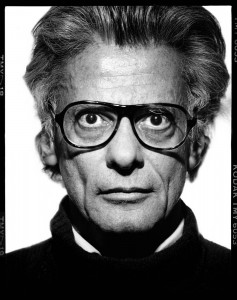RICHARD AVEDON Richard Avedon (1923–2004) was born to parents of Russian Jewish heritage in New York City. As a boy, he learned photography, joining the YMHA Camera Club at the age of twelve; later, he took up poetry, winning a citywide award for high school students during his senior year at DeWitt Clinton in the Bronx.
 Avedon joined the armed forces in 1942 during World War II, serving as Photographer’s Mate Second Class in the Merchant Marine. Making identification portraits of the crewmen with his Rolleiflex twin lens camera—a gift from his father—Avedon advanced his technical knowledge of the medium and began to develop a dynamic style. After two years of service he left the Merchant Marine to work as a photographer, making fashion images and studying with art director Alexey Brodovitch at the Design Laboratory of the New School for Social Research.
Avedon joined the armed forces in 1942 during World War II, serving as Photographer’s Mate Second Class in the Merchant Marine. Making identification portraits of the crewmen with his Rolleiflex twin lens camera—a gift from his father—Avedon advanced his technical knowledge of the medium and began to develop a dynamic style. After two years of service he left the Merchant Marine to work as a photographer, making fashion images and studying with art director Alexey Brodovitch at the Design Laboratory of the New School for Social Research.
In 1945, Avedon set up his own studio and worked as a freelance photographer for various magazines. He quickly became the preeminent photographer used by Harper’s Bazaar. There, under the tutelage of Brodovitch, his rise to the top of the profession was meteoric. Avedon developed an original approach to making fashion photographs. He showed the models full of expression: smiling, laughing, and often posed in action. Inspired by Hungarian photojournalist and fashion photographer Martin Munkácsi, Avedon photographed models and fashions on the streets, in nightclubs and circus arenas, and in other locations then uncommon.
From the beginning, Avedon made portraits for editorial publication as well: in the pages of Harper’s Bazaar, in Theater Arts, and in Life and Look magazines. From the outset, he was fascinated by photography’s capacity for suggesting the personality and evoking the life of his subjects. Only rarely did he idealize people; instead, he presented the face as a kind of landscape, with total clarity. He registered poses, attitudes, hairstyles, clothing and accessories as vital, even revelatory elements of the personal image. “My photographs don’t go below the surface. I have great faith in surfaces. A good one is full of clues.”
“All photographs are accurate. None of them is the truth.”
–Richard Avedon